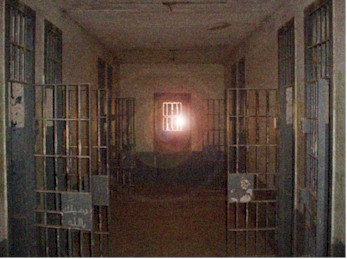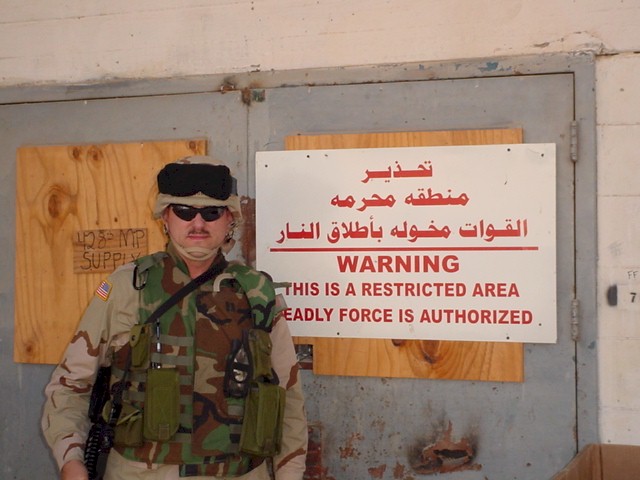Prior to that however,
the inhumane treatment of Iraqi detainees there by a select few American
service men and women in the Fall of 2003, galvanized the world’s
attention. Stark images of hooded and bound prisoners piled like animals in
a myriad of compromising positions and those of inmates with their hands and
genitalia connected to (non electrified wires) only served to ignite
anti-coalition fervor within Iraq. The scandal was serious enough that it
had given a black eye to U.S. lead initiatives throughout the Middle East.
By the time I arrived at
Camp Victory, Baghdad in December 2004, all of the past tabloid media hype
about the prison and its ghastly history under the sadist, Saddam Hussein,
was the farthest thing from my mind. I had more pressing issues to worry
about, that being the random insurgent mortar and rocket attacks on the very
place I was to call home for the next 365 days.
|
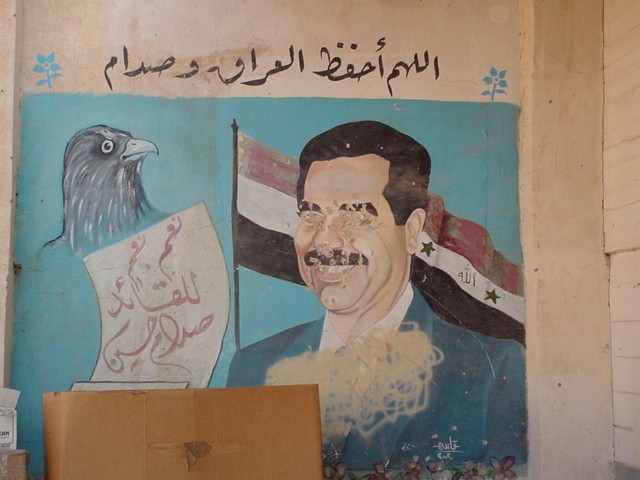 |
In
February 2005, the Design Management Section was tasked with
developing plans for a military detention facility that would
eventually replace the one at Abu Ghraib. To accurately assess
the requirements for a new confinement center, it was imperative
that we know what currently “worked” and what “did not work”
from a technical design standpoint at Abu Ghraib. To find the
answers to these questions, myself and 7 other members of the
Design Management Section were sent on a one day fact finding
tour of Abu Ghraib. Our mission was simple, conduct an onsite
reconnaissance; little did I know what laid in wait for us
there! |
The Baghdad Central
Confinement Facility or “Saddam’s Torture Central” was an American designed
reformatory that had been built by British contractors. It officially
opened its doors in March, 1970. The modern sprawling 280 acre prison
complex complete with numerous imposing guard towers was originally built to
house 4,200 prisoners. The facility was further broken down into five
separate cell blocks each designated to hold different categories of
inmates; foreign prisoners, those serving long sentences, those serving
short sentences, those prisoners who committed “capital crimes and those who
committed “special” crimes. Each individual walled compound contained
cramped 4 by 4 meter cells, crude dining and washing facilities, a prayer
room and exercise yard. When the prison opened, it adhered to strict
international prison standards but when Saddam Hussein took power in 1979,
overcrowding became a problem.
|
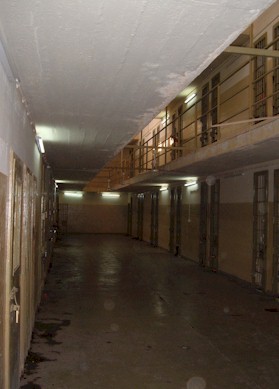
One of the empty
cell blocks at Abu Ghraib. During the Gulf War, members of the
captured British SAS Team "Bravo Two Zero" were incarcerated and
tortured here. |
It was not
uncommon for each cell to hold up to 40 prisoners at any given
time. Here, men who were sentenced to 20 years of incarceration
for stealing a chicken lived side by side with murders, rapists,
and other hardcore criminals. During the first Gulf War, members
of a captured British Special Air Services (SAS) commando team
known as “Bravo Two Zero” were housed at Abu Ghraib while
undergoing extreme physical torture and interrogation.
The area
reserved for Saddam’s most favorite type of scofflaws, better
known as “political prisoners”, was separated into two sections
“open” and “closed”. Shi’ites were imprisoned in the “closed”
wing and were for all intensive purposes held incommunicado from
the outside world until they were released or worse yet
executed.
When Abu
Ghraib was under the control of Saddam and his Ba’athist
cronies, the prison was literally a place synonymous with
brutality and death. It was a symbol of terror that Saddam
gladly used to control the free people of Iraq. Guards at Abu
Ghraib routinely beat prisoners, many of which were being held
without charges. In some instances the unsympathetic guards fed
shredded pieces of plastic to inmates just for fun. Those
detainees fortunate enough to be paroled from “Saddam’s Torture
Central” were gaunt shadows of their former selves. It was said
that “those who go in are lost and those who come out are
reborn”. Life at Abu Ghraib was the epitome of “Cruel” |
Unfortunately many who
entered the gates of Abu Ghraib were never heard from again. In 1984, over
4000 political prisoners were murdered in Saddam’s “Death House” which was
sequestered in an isolated section of the prison. Amnesty International
reported that between 1994 and 2001, more than 333 Shia Muslims were killed
at Abu Ghraib. It is believed that hundreds of unidentified prisoners were
executed there in November 1996 alone. Sadly, these numbers are misleadingly
low. Fearing negative world reaction to the Amnesty International claims of
vicious treatment of inmates at the prison, Saddam had his henchmen carry
out exterminations in secret. Worse yet, it was alleged that some of the
prisoners at Abu Ghraib were used as human guinea pigs in horrendous Iraqi
military chemical and biological weapons tests.
In 2001, Abu Ghraib
reportedly housed over 15,000 prisoners. Prior to the start of Operation
Iraqi Freedom in 2003; plans were made to expand the facility but
construction was put on hold at the onset of hostilities. When U.S. forces
toppled Saddam’s government, many of his former enemies and previous Abu
Ghraib’s alumni boldly returned to loot and pillage the prison. They
defaced images of the former dictator and literally stole anything that was
not bolted down. It was a classic case of the inmates running the asylum.
Today, Abu Ghriab is a
kaleidoscope of both the old and the new. The U.S. currently operates a
detention facility at the site known as “Camp Redemption”. It
is staffed by a professional, caring cadre made up of U.S. and coalition
forces. At any given time, the prison can house several thousand alleged
criminals or captured insurgents. In 2004, the oldest part of Abu Ghraib
was returned to the Iraqi government for use as a civilian correctional
facility. Other than a few technical improvements, the archaic buildings
look the same as they did when Saddam was in power.
When we started our
journey to Abu Ghraib on that sunny winter morning in February, no one
really knew what to expect. First we had to make the perilous trip from
Camp Victory to the prison itself. Going outside of the wire is always a
knuckle biting experience in Iraq. Accompanied by an ominous looking
security escort team, our tiny convoy of up-armored vehicles left the main
gate of Camp Victory loaded for bear and looking for trouble. We traveled
the pot holed roads at breakneck speed hoping to avoid roadside bombs and
ambushes. We slowed, only slightly as we traveled through the various small
villages and hamlets that dot the countryside between Baghdad and our final
destination. When we passed through each town, small children approached
our convoy, hands held high, asking for food and candy. We prayed that the
presence of these innocent kids was not an insurgent ploy to get us “bottled
necked” or worse yet, stopped in a “kill zone”. Once we were sure the
overzealous children were safely off to the side of the road, we picked up
speed and in no time at all, we reached Abu Ghraib. After our short but
intense ride, we as a collective group breathed a sigh of relief when we
finally entered the base. In a country where death is random for friend and
foe alike, we were again as safe as we could be in “war zone”.
From the start, I was
surprised by our reception. Many times, when you show up to visit a
location, you are treated like a “bastard step child” but in this instance
we were treated just the opposite. We were treated like real VIP’s. Our
tour guide was Major Anderson * He had been assigned to Abu Ghraib for the
majority of his tour and in that time he had cultivated many friendships
there. As a result, we were treated to a rare, behind the scenes glimpse of
life at the prison. This included a walk through of the prisoner
in-processing building(s), tours of the various detainee holding areas
within Camp Redemption, and the soldiers living quarters which were nothing
more than retrofitted old cell blocks. Along the way Major Anderson
interjected personal comments, observations and quotes from his tenure at
Abu Ghraib. This human touch brought a whole new dimension to our stopover.
Everywhere we went, we
snapped numerous pictures using our digital cameras. I mention this now
because there is dust everywhere in Iraq. Despite that, every one of our
pictures to this point had been crystal clear and free of anomalies.
Towards the end of our
tour we stopped by the old Iraqi portion of the prison and met with a U.S.
contractor who was “advising” the new Iraqi warden on the best way to run
the facility. This is the portion of Abu Ghraib that is totally reserved
for the incarceration of Iraqi criminals. The U.S. contractor was a very
talkative, good natured, mountain of a man. We learned that he had
previously ran the prison when it was still under coalition control so he
knew the history and the layout of the place like the back of his hand. He
offered to show us the exact location in the prison where all of the
recently sensationalized prisoner abuse photographs had been taken. Who
could pass up a once in a life time opportunity like that!
|
As we made
our way to the cell block in question, I mentioned to the former
warden that the prison seemed to be immersed in a “surreal”
blanket of despair. He agreed without question saying that the
older parts of the prison “played tricks with your mind” and
that it was in those deepest, darkest recesses that he himself
and other people on his staff had seen strange shadows and heard
unearthly disembodied voices when no one else was present. I
would not have expected these kinds of statements from a
prominent civilian contractor. He did not strike me as a
believer in the paranormal and he did not come across as a
skeptic. He was just telling me, matter-of-factly, what it was
like to work inside the prison, especially at night when Abu
Ghraib had an “energy” all its own. |
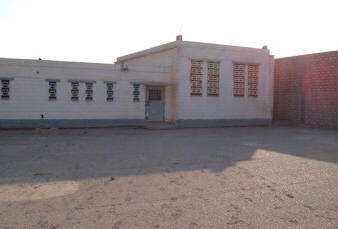
Saddam's Death House -- where
scores of prisoners met their end |
Finally, the coup de
grace! The last place we visited at Abu Ghraib was Saddam’s “Death House”.
It thankfully now stands totally empty, devoid of all human life except for
the occasional visiting dignitary. It is kept from the prying eyes of the
world by a large gate that is always locked day and night. There is no one
standing guard at the gate but when you walk past the entrance, you cannot
help but feel the sting of 1000 unblinking eyes watching you. As Major
Anderson fumbled with the lock, he mentioned something that had happened one
time when he and several of his peers had previously entered the inner
courtyard of the “Death House” to look around. He said that he was standing
there looking in the direction of the Death House when he suddenly had the
unnerving feeling that someone or something was going to slam the huge gate
behind him and his party locking them all inside. Major Anderson said that
no matter how hard he tried to reason with himself, he was unable to shake
his irrational fear even though he knew he had the keys to the gate in his
pocket. First the wardens ghostly comments and now Major Anderson’s candor
on the subject inspired me. I was primed!! With a grin on his face, Major
Anderson pushed open the gate and ushered us into the courtyard of the
“Death House”.
The “Death House” is a
one and a half story building which had been constructed by Saddam Hussein
to rid himself of unwanted human pests and political prisoners. Those
awaiting execution were corralled into 8 small (and I mean small) holding
cells until there was just standing room only. Once the “Death House” was
filled to overflowing with the living, the condemned were escorted to the
“Gallows” where they were hanged two at a time. Others were taken to an
area just below the gallows where their pitiful lives were unceremoniously
snuffed out in a small gas chamber.
According to Major
Anderson, Saddam brought his son’s Uday and Qusay to the “Death House” when
they were 9 or 10 years old to teach them how to torture and kill. It
turned out to be a skill the two brothers perfected to a fine art all the
way up until the start of the U.S. invasion in 2003.
On the day of our
visit, the “Death House” was basked in the scarlet rays of a waning winter’s
sun. I noted that as our small group stood in its shadow; a pal of
uneasiness seemed to settle over us. Smiles were quickly replaced by
straight faces. There was without a doubt, a dark presence emanating from
the silent whitewashed monolith that now dared us to enter.
Cautiously, we walked
around the “Death House” snapping and clicking pictures, amazed that one man
could build such a testament to horror. One by one we entered the building
and were almost instantly enveloped in a cloud of cool damp air that was
laced with the scent of rot and decay. I turned to my left and entered the
cell block where the condemned were held. There before me were 8 open
doors. To me they were nothing more than rusted metal cell doors but for
those unfortunates who looked upon them for the last time, they must have
seemed like toothless mouths, there to devour their very souls.
As I entered one of the
small cells, I closed my eyes and listened. With only 8 people inside the
building the echoes and resulting noise was almost intolerable. I could
only imagine what it must have been like at night, when the cries and pleas
for mercy of hundreds of panicked inmates congealed into one woeful death
song. It must have been an unearthly racket, a resonant energy that
undoubtedly embedded itself into the very fabric of the “Death House” over
the years it was in operation. It was a stir of echoes that you could
literally feel. For me, it was as real as the 220 volt current running
through the walls. The only other time I had felt emotion of that magnitude
was when I had toured Dachau, a German Concentration Camp, in 1996. Feeling
more than a little skittish, I took a few photographs of the area and
rejoined the rest of the group at the gallows.
|
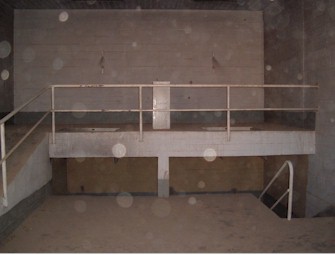
Saddam's Gallows |
Saddam
did not go out of his way to put much creative thought into the
design of his gallows. They were crude, simple and obviously
effective. Gone now were the two hangman’s nooses had been
tied to large iron beams in the ceiling. Prisoners stood over
one of two trapdoors which were separated by the long metal
switch that activated them. The gas chamber lay neatly tucked
away beneath the floor. It was connected to the main room by a
small set of stairs. As I stood there in awe, I noticed cameras
flashing around me and I instinctively pulled mine out of its
case and clicked off a few frames for posterity. I also noticed
another thing, relative silence. No one in the group was
talking, just mumbling to themselves. We were all suddenly very
contemplative and somber. |
A short time later, we
gathered in the courtyard where we talked about our impressions and feelings
while inside the Death House. While I found that it was strange that almost
all of us had experienced an overwhelming feeling of sadness when we walked
through the gallows and the prisoner holding area. I was even more disturbed
when we started to compare our photographs.
As I has mentioned
previously, up until the time we arrived at the Death House, our pictures
had been relatively free of spectral anomalies. This was not to be the case
thereafter. Almost every photograph that I and the rest of the group had
taken while inside the ghastly place was filled with strange mists and
flickering orbs. Even our commanding officer commented that he could not
explain why the strange balls of ghostly light only appeared in the photos
taken while we were in and around the Death House. The fact is that Abu
Ghraib is covered in sand and dust like any other place in Iraq. If the
orbs had been caused by airborne particles they should have been in
virtually every picture we had taken that day, but they were not.
Several weeks later, a
security element from HHD, 20th Engineer Brigade, known as the
“Thunder Cats’ toured Abu Ghraib. I can attest that the “Thunder Kittens”
as we jokingly call them, were wholly unaware of our previous experiences at
Saddam’s “Death House”. Upon their triumphant return to Camp Victory, they
regaled all who would listen of their exploits, specifically the strange
photographs they had taken while inside the Death House. Like us, they had
toured the facility happily taking normal, anomaly free photographs but the
tenor of their pictures took on a more paranormal flare when they were in
the very heart of Saddam’s chamber of death.
For these phenomena to
manifest itself in one specific location in such a prolific manner for two
completely different groups at two different times is unheard of. In my
opinion it is without question a convergence of documented facts that should
make the hair stand up on the back of the necks of any nay-sayers who refuse
to believe that the paranormal world co-exists with our own. The only other
place that I have visited in my travels that excreted the same kind of
melancholy and sometimes malevolent psychic energy I found at Abu Ghraib was
the Concentration Camp at Dachau, Germany. I can assure you I will never
forget either visit.
Abu Ghraib prison, known
to the Iraqis as “Saddam’s Torture Central” was taken from the annals of
relative obscurity and thrust into the public limelight by a scandal that
rocked the foundations of the U.S. military. As brutal and egregious as
these acts were, they pale in comparison to the despicable crimes Saddam and
his sons Uday and Qusay committed against the Iraqi people.
During his reign of
terror, Saddam imprisoned thousands of people, many without charges, within
the walls of Abu Ghraib. The former inmates who lived long enough to
finally see a free Iraq tell stories of how the guards beat and tortured
them or fed them pieces of shredded plastic. It was not until Amnesty
International began to investigate Abu Ghraib that the true horrors of life
inside the prison’s walls became known to the rest of the world.
In 1984 alone, more than
4000 prisoners entered Abu Ghraib and were never heard from again, their
voices silenced by a visit to Saddam’s “Death House”. As the years ticked
away, the murder of innocent Iraqis continued at the prison unabated by
world opinion or pressure until the U.S. lead invasion ousted Saddam in
2003. Invariably all of this death, hatred, and emotional distress were
absorbed by Abu Ghraib itself, creating an impermeable barrier between this
world and the next. Abu Ghraib became a prison for the dead as well as the
living.
But from the ashes rise
the Phoenix. Gone are the days of torture and death at Abu Ghraib.
Following several intense inquiries into the 2003 scandal, sweeping changes
were made at the prison. The soldier living areas were vastly improved and
safeguards put into place to preserve the safety of those detained there.
The “old guard” was replaced with better trained and better equipped
soldiers. These brave men and women strap on their body armor everyday and
face not only a defiant insurgency but also the constant reminders of the
prison’s haunting past. Here in the desert just a scant few miles away from
Baghdad, the ghostly images of Abu Ghraib’s former inmates refuse to remain
silent. It is a place where the sweat and blood of hero’s co-exist with a
lineage of tears and pain making “Saddam’s Torture Central” one of the most
haunted locations in all of Iraq.
Sources:
